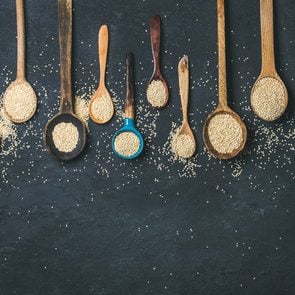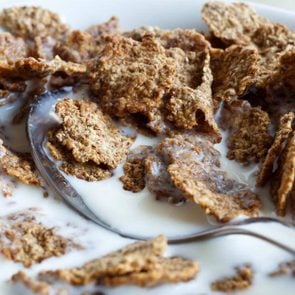The 5 Best Healthy Food Trends of 2020
Updated: Mar. 31, 2021
Take a walk down memory lane with these 2020 food trends, like plant-based protein, dietitians hope will continue into 2021—and beyond.
Our editors and experts handpick every product we feature. We may earn a commission from your purchases.
A look back at healthy food trends 2020
Just 12 months ago, most of us had no idea what Covid-19 was. Nor could we have predicted the countless ways the pandemic has changed society. From the mask-wearing to a toilet paper shortage to the race for a Covid-19 vaccine—and, most importantly, the hundreds of thousands of lives lost. The novel coronavirus has flipped our world upside down.
It has also drastically changed the way we eat. A whopping 85 percent of Americans report altering their eating and food-shopping habits this year, according to the 2020 Food & Health Survey from the International Food Information Council (IFIC).
Back in January, we peered into the crystal ball and guessed that adaptogens, alternative flours, plant-based eating, and gluten-free swaps would be among the top healthy food trends of 2020. Many of those held true. But they took a back seat to unexpected healthy food trends like stress-baking sourdough bread, an increase in snacking, and a booming bean industry.
So now that we’ve been there, survived that rollercoaster of a year, let’s look back at the positive changes we’ve made. Here are the top healthy food trends of 2020 dietitians hope will continue into 2021.

Cooking at home more often
While restaurant delivery has seen a jump, indoor and even outdoor dining has been restricted or mandated to close in many states. As a result, that same IFIC survey revealed that 60 percent of us are cooking at home more often. What’s more, 64 percent of a pool of 2,000 Americans surveyed by the research company Highland reported spending less money on restaurant meals in 2020.
“From a nutritional standpoint, that likely means less added fat, sodium, and sugar than one would typically find in prepared or takeout meals,” says Lauren Harris-Pincus, RDN, founder of Nutrition Starring YOU and author of The Protein-Packed Breakfast Club. “Hopefully, people will have gained cooking skills and tried new foods that they will continue to consume once life in America reverts back to some sense of normalcy.”
(If you do want to order in, here’s how to safely enjoy takeout during coronavirus.)
Online grocery shopping
Filling up virtual carts became a national pastime as Americans attempted to avoid supermarket crowds or lines caused by capacity limits. More than half of us have purchased groceries online this year, double those who did so just two years ago, according to the Coresight Research U.S. Online Grocery Survey 2020.
That’s great news for avoiding germs. But it might not be so great regarding ease of nutrition info. According to a study published in October 2020 in the Journal of Nutrition Education and Behavior, about 15 percent of foods sold online don’t list full nutrition or ingredient info. As a result, more legwork is required to make well-informed, healthful choices.
Amazon, Walmart, and Target—the three most-shopped virtual grocers in that Coresight survey—often list these. But if you find you’re coming up short, you can Google the product for its brand website to find the specifics.
(Prefer to go to an actual store? Here are the foods nutritionists buy at Costco.)
Prioritizing plant-based protein
“During the pandemic there was concern regarding meat availability, encouraging people to try alternatives,” says Gabby Geerts, RD, a registered dietitian with Green Chef in Boulder, Colorado.
There were also work-safety concerns for those employed in meatpacking plants forced to remain open, as well as mounting scientific evidence that replacing red meat with plant proteins may lower your risk for heart disease. (Here are the 15 sources of high-quality plant-based protein to try.)
“There has been an increase in awareness and education surrounding plant protein,” says Geerts. “Not only can it have health benefits—decreased risk of cardiovascular disease, diabetes, stroke; increased lifespan and quality of life—but it’s also better for the environment and sustainability initiatives. Read labels carefully and focus on natural plant proteins, like beans and nuts.”
People who have followed a diet in the past year are even more likely than the average American to indicate they eat more protein from plant sources (41 percent vs. 18 percent), Harris-Pincus says.
“Plant protein is a hot topic in the nutrition world with food cost and sustainability top of mind for some, and better nutrition as a goal for others. Fiber, whole grains and protein from plant sources are viewed as the healthiest food choices,” explains Harris-Pincus.
“This increases consumer curiosity to try all of the new plant-based ‘faux meat’ products on the market such as Impossible Burger, Beyond Meat, and Incogmeato,” she adds. “Nutritionally, it’s important for people to focus on whole food sources of plant protein—like legumes, nuts, seeds, and whole grains—first. And enjoy the more processed meat replacements sparingly.”
(Here are some plant-based food trends for 2021.)
Eating more chickpeas (not hummus)
Remember those beans we mentioned? Sure, we’re putting garbanzos to good use in hummus, falafel, curries, and soups. But we’re also devouring our fair share of foods bolstered with chickpea-derived components. We’re talking pizza crusts made with chickpea flour, ice cream with incognito chickpeas, and sandwich spreads with vegan mayonnaise stabilized by aquafaba (the liquid portion of a can of chickpeas that can act as an egg replacement).
“Chickpeas are one of those great plant sources of protein, with a half-cup containing about seven grams of protein and five grams of fiber,” Geerts says. “They’re incredibly versatile and provide a gluten-free option that can mimic the texture of the carbohydrates in breads, crusts, and chips. Roast for a crunchy texture, puree into a sauce, mash into a fritter, or simply boil and sprinkle them on a salad.” (Here’s a full run-through of chickpea nutrition facts.)
(Prefer hummus? Here’s how to make your own hummus.)
Eating more fermented foods
These gut health breakthroughs have been changing the way we eat this decade (see: the probiotic-boosted Greek yogurt-palooza, circa 2010). But 2020 has brought gut bacteria even more to the forefront as we increase our evidence pool about its impact on two very timely topics: mental health and immunity.
As a result, the availability and sales of everything from kimchi to hard kombucha are climbing. (By the way, if you like kombucha, you need to try this tepache recipe.)
“The more we learn about fermented foods, the more we encourage consumption,” Geerts says. “They have positive effects on our gastrointestinal tract and immune system by providing beneficial probiotic bacteria that may help raise levels of naturally-protective immune cells called neutrophils circulating in the blood.”
For a preview of what’s to come in the 365 days ahead, check out what our friends at Taste of Home think will be new and next in the world of food in 2021.



